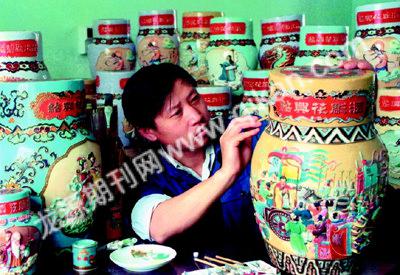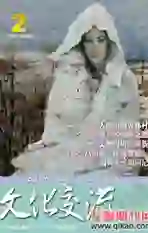Art of Decorated Wine Jars
2009-06-08XuXiaoyang
Xu Xiaoyang

Shaoxing, a city of history and culture in eastern Zhejiang Province, boasts Shaoxing Huadiao. Today, however, the name gives rise to some confusion, for Shaoxing Huadiao (which literally means floral sculpture produced in Shaoxing) refers to a famed brand of yellow wine, the yellow wine of this brand, the pottery jars used for containing the mellow beverage, and the art of the jar decoration. The confusion does not stop at the four meanings. When it comes to describing the jar decoration, floral sculpture actually refers to a wide range of subjects beyond flowers and artistic means beyond sculpture. And when it comes to the history of Huadiao, the art used to have nothing to do with sculpture at all.
The tradition in Shaoxing of putting the rice wine in a decorated jar and presenting a decorated jar of rice wine as a precious gift goes back centuries. A porcelain wine jar, made in the early Southern Song Dynasty (1127-1279) and now in the collection of Shanghai Museum, testifies to the ancient genesis of the tradition. The jar carries an inscription in calligraphy as well as drawings of flowers and birds and some geometric shapes. The art became popular in the mid Qing Dynasty (1644-1911). For a long while, such jars of homemade rice wine were manufactured and presented exclusively as dowries in Shaoxing. In the late Qing Dynasty, the mellow wine came in jars with painted patterns in bright colors for memorial rites, birthday celebrations, construction projects and opening ceremonies of business.
As the wine jars became popular, the village artists whose jobs had been decorating Buddhist temples, residential houses and furniture were able to make a living out of decorating wine jars. Local artists proudly remember that a wine jar decorated with a painting of the dragon and the phoenix, auspicious symbols for prosperity, was chosen for a court wedding ceremony in the late Qing Dynasty. It is said that a wine shop in Shanghai once displayed wine jars decorated with drawings done Ren Bonian (1840-1895), who went on to become a leading artist of China in the days of the late Qing Dynasty.
In the early 20th century, most wine jars in Shaoxing were decorated with paintings of figures and flowers. Some artists, however, began to introduce other art forms. Some adopted techniques of lacquerwork and some put oiled clay onto the surface of a jar before sculpting the clay and applying colors to the patterns and adding inscriptions. The innovative experiments have lead to jars with high relief decorations in bright colors.
The art of jar decoration in Shaoxing has evolved so much that a wide range of sculpture techniques are now used. Theories are also advanced as guidelines for practice and further exploration. Applying colors to high relief and calligraphy has also matured into a system of techniques and a complete set of dos and donts. Today, wine jar artists in Shaoxing boast a repertoire of over 2,000 variations of about 200 themes for yellow-wine jar decorations.
The innovative decoration helped the marketing of the yellow wine. The modernization drive in the past 30 years has witnessed a quantum leap in the development of jar decoration and sales volume of yellow wine in Shaoxing. There have appeared studios for research and development of new patterns and procedures. Output has soared from merely 200 jars at first to 50,000 units a year today and designs have widened and techniques have become refined and sophisticated. Xu Fupei, a provincial crafts master, is a leading artist for sculpted jars and has won top honors at home and abroad.
When it comes to the glory of the Shaoxing yellow wine in decorated jars, local people can easily cite new examples to justify their pride. In 1992, the jarred wine from Shaoxing was chosen by the Ministry of Foreign Affairs as a gift for the visiting Japanese Emperor and in 1998 Huadiao was also chosen as a gift for the visiting American President Clinton.□
